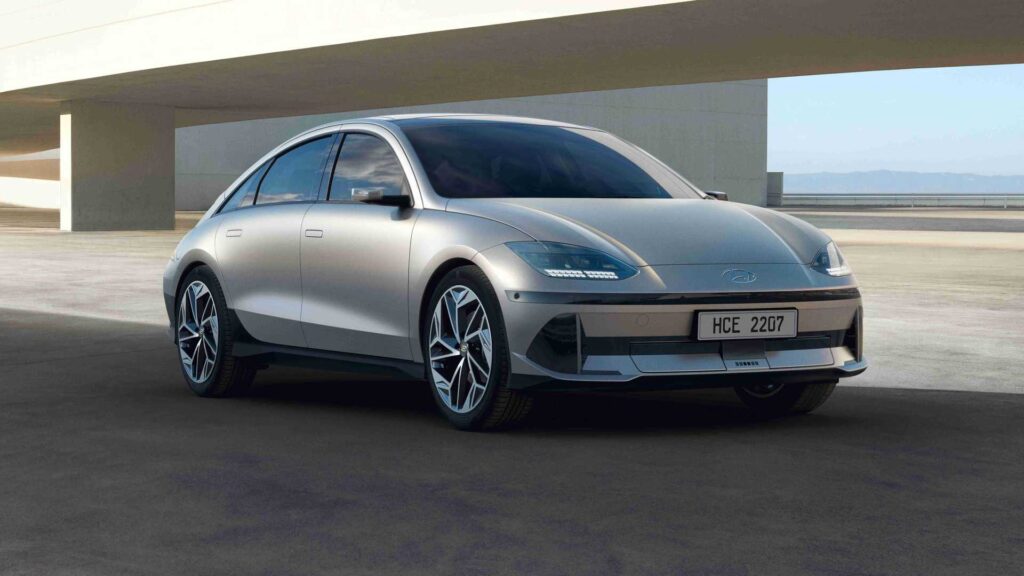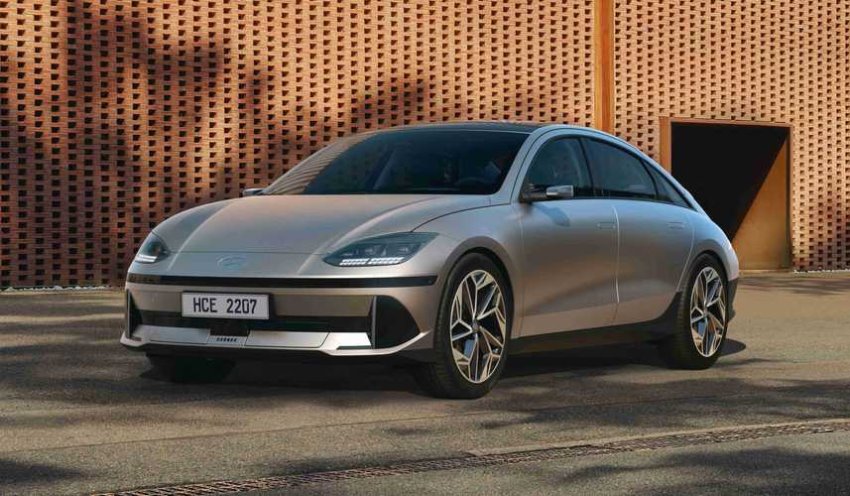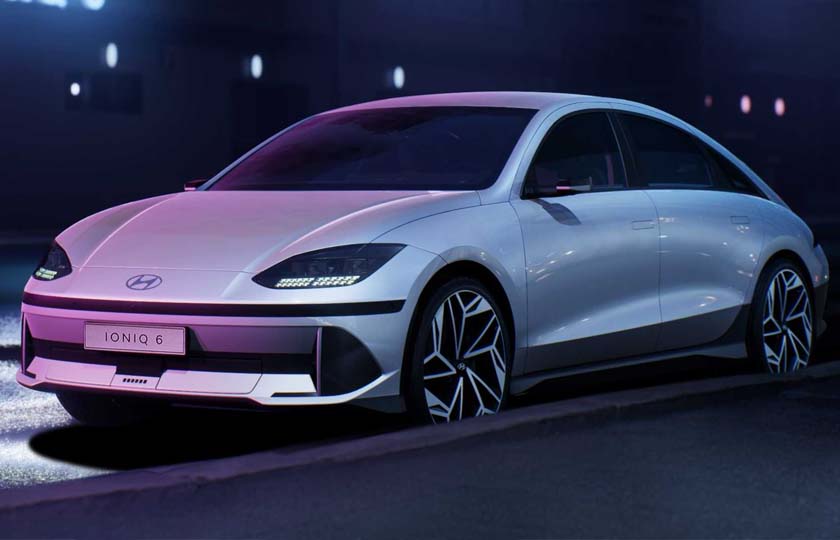The Hyundai Ioniq 6 is a groundbreaking fusion of sleek design, cutting-edge technology, and eco-friendly performance, setting new standards in the realm of electric vehicles. With its futuristic aesthetics and innovative engineering, this electrifying sedan embodies Hyundai’s commitment to sustainable mobility without compromising on style or driving experience. Pioneering the next generation of electric vehicles, the Ioniq 6 stands at the forefront of automotive innovation, promising an exhilarating blend of efficiency, elegance, and intelligent design.
The name Ioniq is a word consisting of two independent words, Ion (Ion) and Unique (Unique), which formed the word Ioniq to indicate the new electric car series of the South Korean brand Hyundai from 2021. But this name was by no means new, because in 2016, Hyundai launched a model called Ioniq, which was the first step of this car manufacturer in the direction of producing a car without a conventional internal combustion engine, and instead a hybrid or all-electric vehicle. It was electric.
With the arrival of the Ioniq 5 in 2021, it is now the turn of the Ioniq 6 to be the first of the 17 all-electric vehicles promised by the Hyundai Motor Group in the next eight years.
Technical specifications of Hyundai Ioniq 6:
Among the top three all-electric cars (EV) of last year, the names of the Hyundai Ioniq 5, Kia EV6 and Ford Mustang Mach-E can be seen in the first to third positions, respectively. Knowing that the Kia brand is also partially owned by the Hyundai Motor Group, this marks the first and second victory of this brand in the North American electric car market.
Also, in the European market, Ionic 5 won two global design awards and the world’s best electric car in 2022. This victory means putting aside cars such as Mercedes-Benz EQS and Audi E-Tron GT and giving a crooked mouth to the top car manufacturers in the European market. So, the Ionic brand has started with strength and Model 6 is one of the 17 all-electric cars that Hyundai Automobile Group has promised to the world for the next eight years.
The first and most obvious thing about Ionic 6 is its design style. A liftback sedan (or maybe even a coupe, like the Mercedes-Benz CLS) that, from an aerodynamic point of view, has a final drag coefficient of 0.21. What is the significance of this number? Mercedes-Benz EQS claims to have the record for the highest drag coefficient among cars in history, it has a drag coefficient of 0.20, now imagine a car from the Hyundai brand, as close as a hair to this number. The director of the Hyundai Global Design Center also describes the design of Ionic 6 with the word Streamliner, which was a special style of aerodynamic design in trains produced between the 1930s and 1950s, whose design style penetrated the automotive industry as well. The tear drop design style is also one of the most important elements used in the streamliner design style, which was used in various cars.
Unlike the Ionic 5 and Ionic 7 SUVs that will be launched in the future, the 6 model of this brand is a performance-oriented car for people who are not necessarily looking for more interior space and higher luxury. As a result, the Ioniq 6 is equipped with more tricks such as active flaps that increase aerodynamics, tires attached to the arches of the fenders and thinner than usual digital side mirrors, which will have a positive effect on the unannounced final range of this all-electric car.
Ionic 6, like Ionic 5, is based on Hyundai’s 800V E-GMP all-electric structure. As a result, like Model 5, and if needed, it has the ability to transmit electrical power to start household electrical equipment such as television, vacuum cleaner, and blender. So as long as you can fit your electrical equipment in it, this vehicle can be a mobile home or a small non-off-road camper.
No detailed and detailed information about the technical features of Ionic 6 has been published yet, but considering the platform sharing with Ionic 5, it is expected that Ionic 6 will also use very close (or even similar) features. As a result, the table below shows the possible specifications of the dual differential version of Full Ionic 6

General specifications
Engine type
all electric (EV)
Engine specifications
Two electric motors/173 kW
Cylinder / valve
–
engine breather
–
the power
320 horsepower in total
torque
600 newton meters in total
gearbox
single speed
drive shaft
Two differentials
acceleration
About 5 seconds
Speed
–
Fuel consumption
–
Emission standard
Euro 6
Command
electric
body type
Small size sedan
Rim type
Aluminium
Options and features
Cruise control
has it
Smart cruise control
has it
Uphill stability control
has it
Downhill speed control
has it
Traction control
has it
Stability control
has it
auto park
–
Front sensor
has it
Rear sensor
has it
Blind spot radar
has it
Lane change radar
has it
Front crash radar
has it
Rear crash radar
has it
ABS
has it
Auxiliary brake
has it
Emergency brake
has it
Electric parking brake
has it
Autolite
has it
daylight
has it
Steering wheel control buttons
has it
steering wheel heater
has it
Information and entertainment display
has it
navigation
has it
Heads up display
does not have
rear camera
has it
Side camera
–
360 degree camera
–
Air bag
has it
Keyless entry
has it
Keyless start
has it
Automatic ventilation
has it
Electric driver’s seat
has it
Electric front passenger seat
has it
Front seat heater
–
Front seat cooler
–
Electric side mirror
has it
Side mirror heater
has it
panorama
–
sunroof
–

Appearance design:
Belonging to the sedan segment, Ionic 6 has a very tangible and visible feature, which is nothing but the very large distance between the axles. Since this car is an all-electric product, there is no need for the design of the technical part and its driving forces to be very complicated. The great advantage of fully electric cars is the possibility of arranging batteries, control systems and engines in a suitable shape and image with the design of the platform and the external appearance of the car, which leaves the hands of engineers and designers much more open and free.
As a result, the angles of attack and escape in this car are very short, which is one of the most important elements in sports cars. After that, the effect of the long distance between the axles on the interior of the car is undeniable.
The side view of the car is a set of very soft and beautiful arches, and broken and sharp elements are almost invisible in the appearance of the car. The appearance of the liftback is similar to the rear part of the car, similar to a coupe sedan, something similar to the Mercedes-Benz CLS. The ultra-slim side mirrors house the rearview cameras, which will no doubt be replaced by real mirrors in the mass-production version, as US federal standards do not yet allow automakers to use cameras instead of mirrors.
Before you get past the cute and futuristic look of the Ionic 6, you should know that no line and no part of this car’s body has been designed without considering the impact on aerodynamic features. Even the air inlets and outlets in the two corners of the front and rear bumpers, and of course the rear spoiler along with the two-step hazard light that is beautifully engraved in the rear part of the car, are all effective in achieving the 0.21 Ionic 6 drag coefficient.

interior design :
Like most of today’s forward-thinking all-electric cars, the Ioniq 6 has minimized the use of switches and mechanical devices. The set of control and display tools of the car is a total of two 12.0-inch touch screens placed next to each other. This design style is used by car manufacturers such as Mercedes-Benz and some Chinese companies.
The middle console is completely flat, wide and spacious, and it has a wireless charger in its heart that can easily hold and charge a large tablet or a laptop. But the most attractive feature used in the Ionic 6 is the use of the abstract lighting system inside the cabin, which is not considered a new option, but in this car, it can be adjusted with 64 separate and desired colors for the passengers. There are also six preset two-tone patterns, and the Sport mode changes the color of the interior based on the car’s current speed.
Apart from these cases, one of the most obvious strengths of Hyundai Ioniq 6 is the use of recyclable and clean materials in order to reduce the amount of pollution and human impact on the environment. The company makes great efforts to keep its products clean, not only from the point of view of energy consumption, but in every way.
Challenges of Hyundai Ioniq 6:
- Competition in the EV Market: The electric vehicle market is highly competitive, with many established and new players offering diverse options. The Ioniq 6 might face challenges in distinguishing itself and capturing market share among other compelling electric cars.
- Charging Infrastructure: Despite advancements in charging technology, the availability and accessibility of fast-charging infrastructure remain a concern in certain regions. This limitation might impact the overall convenience and usability of the Ioniq 6.
- Range Anxiety: Even with improvements in battery technology, range anxiety might persist for some potential buyers. Addressing this concern and providing sufficient range on a single charge will be crucial for customer adoption.
- Price Point: Advanced technology and premium features often come at a cost. Depending on its pricing strategy, the Ioniq 6 might face challenges in justifying its price against other EVs with similar or competitive features.
- Initial Market Availability: The Ioniq 6 might have limited availability initially, potentially limiting its accessibility to consumers in various regions, which could slow down its market penetration and adoption.
- Customer Perception: Hyundai’s positioning in the electric vehicle segment compared to established EV brands might affect consumer perception. Overcoming any preconceived notions or establishing itself as a competitive option could pose a challenge.
- Regulatory Changes: Changes in government policies, incentives, or regulations related to electric vehicles could impact the market dynamics and sales of the Ioniq 6, requiring adaptation to evolving industry standards.
Comparison between Hyundai Ioniq 6 and Tesla Model 3 :
Performance:
- The Tesla Model 3 is known for its impressive acceleration and performance. Its top-tier models boast quick acceleration times and excellent handling.
- Anticipated performance for the Ioniq 6 might aim for efficiency and decent performance but might not match the high-end performance figures of the Tesla Model 3.
Range:
- Tesla Model 3 offers varying ranges depending on the model, with some versions providing over 300 miles on a single charge.
- The range for the Ioniq 6 hasn’t been officially announced, but Hyundai’s Ioniq line typically offers competitive range, possibly approaching or exceeding 200-300 miles.
Charging Infrastructure:
- Tesla has an extensive and well-established Supercharger network, providing fast-charging capabilities across many regions.
- Hyundai’s charging infrastructure might rely more on third-party networks, which could impact convenience and availability in some areas.
Technology and Features:
- Tesla Model 3 is known for its cutting-edge technology, including its Autopilot system and over-the-air updates, constantly improving the car’s features and capabilities.
- The Ioniq 6 might offer advanced technology and features, but the extent and capabilities haven’t been detailed.
Price:
- Tesla Model 3’s pricing varies based on the model and features but generally positions itself in the mid to higher price range among electric vehicles.
- Hyundai tends to position its vehicles competitively, possibly offering the Ioniq 6 at a more accessible price point compared to some Tesla Model 3 variants.
Brand Perception and Recognition:
- Tesla has established itself as a pioneering brand in the electric vehicle industry, known for its innovation and technology.
- Hyundai, while a prominent automotive manufacturer, might face challenges in brand perception and recognition in the premium electric vehicle segment compared to Tesla.

Conclusion :
The Hyundai Ioniq 6 represents an exciting venture into the realm of electric vehicles, poised to combine Hyundai’s commitment to innovation, sustainability, and design. While specific details about the Ioniq 6 might not be readily available, the anticipation is high given Hyundai’s track record with its Ioniq line.
Expected to blend sleek aesthetics, advanced technology, and eco-friendly performance, the Ioniq 6 aims to carve its niche in the competitive electric vehicle market. Potential features such as an efficient electric powertrain, cutting-edge connectivity, and a focus on safety and sustainability hint at a promising future for this model.
However, the Ioniq 6 might encounter challenges typical of new entries into the electric vehicle segment, including competition from established brands, charging infrastructure considerations, and establishing its brand perception among consumers.
Until its official release and comprehensive reviews become available, the true potential and performance of the Hyundai Ioniq 6 remain to be seen. Nonetheless, the Ioniq 6 signifies Hyundai’s continued dedication to pushing the boundaries of electric vehicle technology and furthering the evolution of sustainable mobility
For more information, visit the official website of Hyundai Ioniq 6
Read this article : Tesla model 3

Leave a Reply